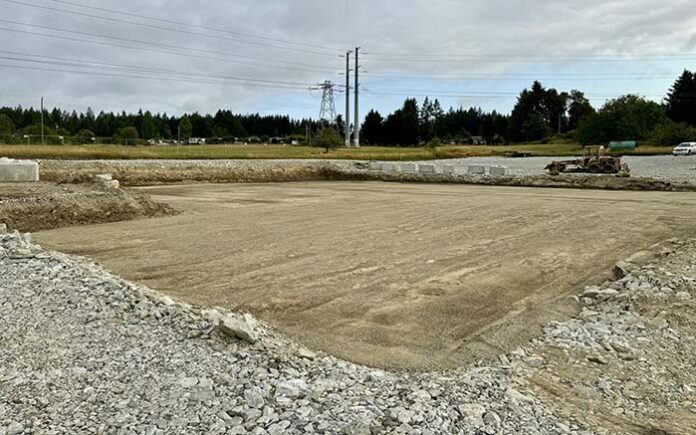As officials mark a spending milestone, the metaphorical sound of crickets at the future site of Salt Spring’s new fire hall is coming to an end.
With the first million dollars of the $12.5-million project spent, per a report to Salt Spring Island Fire Protection District (SSIFPD) trustees, CAO Rodney Dieleman said Monday, July 22 the Capital Regional District (CRD) was issuing the foundation permit for the new core fire hall, and work was set to start “within the next day or so.”
Money spent thus far has been allocated to design, drawings and engineering for the new facility, Dieleman told fire board trustees at the district’s July 15 meeting, as well as paying the first two invoices for civil work –– everything contractors could complete without the issuance of building permits from the CRD.
The delay in getting that permit was visibly frustrating for trustees, who said they were fielding questions from the public on what was going on at the site since the CRD building inspector first received plans at the beginning of April; the building permit process was expected to take six to eight weeks and is now marking week 13.
“The full building permit is expected to take a couple more weeks,” said Dieleman. “CRD staff and our team have been collaborating on solutions for accessibility and the construction of a hose tower.”
Project owner’s representative Hans Hazenboom told trustees there had been requests for clarifications on several aspects of the fire hall plans, which he admitted seemed a little “onerous” even compared to other major Salt Spring projects he’d been a part of over the years.
“In any case, we have to answer the questions that are being raised,” said Hazenboom. “That has been done over time, six different iterations.”
Construction, Hazenboom explained, is being held to the newly released building code, which is updated every few years and tends toward improving accessibility in public buildings –– a good thing generally, he agreed. But questions had cropped up on whether the 2024 building code would necessitate an elevator to reach the second storey of the new fire hall, or whether some other accommodation could satisfy accessibility requirements.
Hazenboom told trustees he was hopeful for a “common sense” solution, given the second floor was envisioned as a workplace accessed only by active firefighters; the new hall’s sleeping quarters, exercise equipment and kitchen will fill that floor, he said, likely behind a secured door with no public access.
The building code also imposes stricter requirements for post-disaster construction, Dieleman said, and the CRD is specifying the tall hose tower –– despite not being an inhabited part of the structure like the core fire hall building–– should also be built to that standard. Dieleman said the district is proposing relocating the tower away from the main facility, separating the structures during a seismic event. District consultants are submitting those revised hose tower designs to meet the building inspector’s concerns, he said, which involves some re-design and review time.
“Staff and the consultants are working with the CRD staff to obtain the building permits,” Dieleman told trustees. “And we’re going through different negotiations and alterations. It’s frustrating, but that is the process.”
Trustee Robin Williams made a point of noting Salt Spring’s CRD director Gary Holman had taken the time to get involved and had been supportive of the district’s positions.
“My comment would be about the CRD,” said Williams. “The CRD has kind of an unwritten policy where they pretty well totally shut down in August. So again, the timing is really of the essence.”
But, Dieleman said this week, he is pleased the foundation work would be progressing, and confident the rest of the process would play out well.
“The district values the professional review conducted by the CRD building inspector,” said Dieleman. “The community will benefit from a well-designed fire hall that meets post-disaster standards in 2024.”
The project still faces what seems to be an administrative delay for the fire hall’s highway access permit from the Ministry of Transportation and Infrastructure. Hazenboom said ministry staff had told him their application was “on the engineer’s desk.”
Meanwhile, and perhaps demonstrating their optimism, SSIFPD staff included move-out expenses in the coming year’s proposed budget –– a $40,000 one-time allocation that will include decommissioning pumps, compressors, radios and electrical work as well as transporting equipment out of the old fire hall and into the new one.
That 2025 draft budget was received and a taxation bylaw approved for first reading by trustees this month, with a projected total $5.65 million in expenditures, up 9.88 per cent from 2024. That first reading is just the beginning of the public engagement process, according to board chair Rollie Cook, who said trustees were continuing with the long-running tradition of presenting the draft budget to attendees at a town hall for their input.
That town hall is set to take place at 7 p.m. on Monday, Sept. 9 at the fire hall in Ganges.

